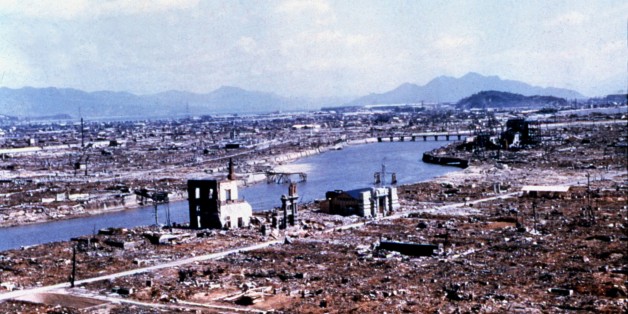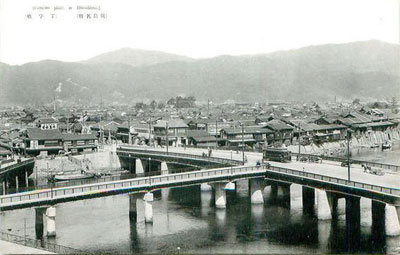US President in Hiroshima
US President Barack Obama visited today (May 27, 2016 in Japan Time) Hiroshima to show his concern about nuclear crises and nuclear threats.
(Due to the air bombardment with just one atomic bomb by the US military on Hirohima on August 6, 1945, 140,000 citizens, soldiers, and prisoners of war who happened to be in the west Japan city died immediately or gradually due to radioactive influences till December 1945.)
The reason why nuclear weapons pose so great challenges to humanity is that as its demolition power is so huge that its use means a kind of annihilation of not only enemy troops but also enemy civilians.
But before the use of atomic bombs onto Hiroshima and Nagasaki in August 1945, belligerent nations in WWII had adopted a kind of annihilation tactics: a large-scale blanket or carpet bombings.
The bombing of Dresden was a British/American aerial bombing attack on the city of Dresden, the capital of the German state of Saxony, that took place during the Second World War in the European Theatre. In four raids between 13 and 15 February 1945, 722 heavy bombers of the British Royal Air Force (RAF) and 527 of the United States Army Air Forces (USAAF) dropped more than 3,900 tons of high-explosive bombs and incendiary devices on the city.[1] The bombing and the resulting firestorm destroyed over 1,600 acres (6.5 km2) of the city centre.[2] An estimated 22,700[3] to 25,000[4] people were killed.No matter if conventional bombs are used, the aerial bombardment on a city is actually targeting citizens. So, there is no difference between an attack on a city using one atomic bomb and an attack on a city using thousands of conventional bombs.
https://en.wikipedia.org/wiki/Bombing_of_Dresden_in_World_War_II
The Bombing of Tokyo, often referred to as a series of firebombing raids, was conducted as part of the air raids on Japan by the United States Army Air Forces during the Pacific campaigns of World War II...
On the night of 9–10 March ("Operation Meetinghouse"),[12] 334 B-29s took off to raid with 279 of them dropping 1,665 tons of bombs on Tokyo. The bombs were mostly the 500-pound (230 kg) E-46 cluster bomb which released 38 napalm-carrying M-69 incendiary bomblets at an altitude of 2,000–2,500 ft (610–760 m). The M-69s punched through thin roofing material or landed on the ground; in either case they ignited 3–5 seconds later, throwing out a jet of flaming napalm globs. A lesser number of M-47 incendiaries was also dropped: the M-47 was a 100-pound (45 kg) jelled-gasoline and white phosphorus bomb which ignited upon impact. In the first two hours of the raid, 226 of the attacking aircraft unloaded their bombs to overwhelm the city's fire defenses.[13] The first B-29s to arrive dropped bombs in a large X pattern centered in Tokyo's densely populated working class district near the docks in both Koto and Chuo city wards on the water; later aircraft simply aimed near this flaming X. The individual fires caused by the bombs joined to create a general conflagration, which would have been classified as a firestorm but for prevailing winds gusting at 17 to 28 mph (27 to 45 km/h).[14] Approximately 15.8 square miles (4,090 ha) of the city was destroyed and some 100,000 people are estimated to have died.
https://en.wikipedia.org/wiki/Bombing_of_Tokyo
However, an air raid using hundreds or thousands of conventional bombs in on a city was an extension of an air raid to military installations. The paradigm was not annihilation of citizens but destruction of buildings, facilities and functions of a city and military installations around the city. It was not assumed that carpet bombing could kill all the residents in a city, since bombing could not be so dense and concentrated, though the Bombing of Tokyo triggered large-scale fires in down towns of Tokyo that killed so many human lives in addition to burning hundreds of thousands of houses and buildings.
But an air bombardment using one nuclear bomb is a different paradigm. As it is apparent that the huge blast of the bomb could surely kill tens of thousands of people, a nuclear bomb attack means annihilation of residents in a city rather than demolition of city functions and military facilities or making enemy citizens lose the will to fight.
The modern warfare is all-out war. Warring nations mobilize all the industrial power they have. Therefore they target industrial bases of enemy countries including cities. And they would finally target citizens of enemy countries, since human resources are also resources of their industry. Against this background, the atomic bombs were developed and used by the US military onto the two cities, Hiroshima and Nagasaki, of the Imperial Japan at the last stage of WWII.
Now any big city, such as New York, can be destroyed with hundreds of thousands of deaths by a few nuclear missiles, each of which is 100 times more powerful than the Hiroshima-type atomic bomb. Therefore, the US and all the other nations in the world should stop keeping nuclear weapons and intimidating other nations with nuclear weapons. The use of weapons imply not only the will to win a war but also an intention of killing children, women, old men, and all the noncombatants of cities and everywhere of an enemy country.
Now any big city, such as New York, can be destroyed with hundreds of thousands of deaths by a few nuclear missiles, each of which is 100 times more powerful than the Hiroshima-type atomic bomb. Therefore, the US and all the other nations in the world should stop keeping nuclear weapons and intimidating other nations with nuclear weapons. The use of weapons imply not only the will to win a war but also an intention of killing children, women, old men, and all the noncombatants of cities and everywhere of an enemy country.
And, it is absurd and evil for mankind to try to develop weapons more powerful than nuclear weapons.

Hiroshima after the atomic bomb attack in August 1945
http://www.huffingtonpost.com/setsuko-thurlow/70-years-after-hiroshima_b_7941322.html

Hiroshima before the atomic bomb attack
http://tsubaki352.at.webry.info/200808/article_1.html
Hiroshima before the atomic bomb attack
http://www.tooa.jp/hari-story.html
**** **** ****
Luk 5:26 And they were all amazed, and they glorified God, and were filled with fear, saying, We have seen strange things to day.
Luk 5:27 And after these things he went forth, and saw a publican, named Levi, sitting at the receipt of custom: and he said unto him, Follow me.
Luk 5:28 And he left all, rose up, and followed him.

Hiroshima after the atomic bomb attack in August 1945
http://www.huffingtonpost.com/setsuko-thurlow/70-years-after-hiroshima_b_7941322.html
Hiroshima before the atomic bomb attack
http://tsubaki352.at.webry.info/200808/article_1.html

Hiroshima before the atomic bomb attack
http://www.tooa.jp/hari-story.html
**** **** ****
Luk 5:26 And they were all amazed, and they glorified God, and were filled with fear, saying, We have seen strange things to day.
Luk 5:27 And after these things he went forth, and saw a publican, named Levi, sitting at the receipt of custom: and he said unto him, Follow me.
Luk 5:28 And he left all, rose up, and followed him.
